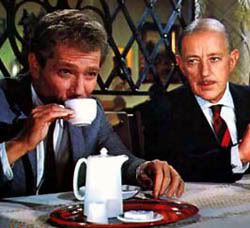The 1960s was a very popular decade for spy movies, what with the Cold War going on, and a loosening of restrictions on filmmaking thanks to various social changes. Berlin, a divided city where East and West were cheek by jowl, was a popular location for spies. One such Berlin-set spy movie, The Quiller Memorandum, is airing on the Fox Movie Channel on May 15 at 10:00 AM ET. George Segal stars as Quiller, a British spy. A couple of his colleageus are killed in Berlin when they're investigating the shadowy West German neo-Nazi movement. Quiller's handler, Pol (played by Alec Guinness) then brings in Quiller to send him to West Berlin to find out what happened, and infiltrate the neo-Nazis. Of course, as is the case with spy movies, you know the spy is going to face danger; in this case, that's Max von Sydow, as the head of the movement. There's also the standard love interest, in this case a school teacher played by Senta Berger.
George Segal stars as Quiller, a British spy. A couple of his colleageus are killed in Berlin when they're investigating the shadowy West German neo-Nazi movement. Quiller's handler, Pol (played by Alec Guinness) then brings in Quiller to send him to West Berlin to find out what happened, and infiltrate the neo-Nazis. Of course, as is the case with spy movies, you know the spy is going to face danger; in this case, that's Max von Sydow, as the head of the movement. There's also the standard love interest, in this case a school teacher played by Senta Berger.
The Quiller Memorandum is a dark spy movie, although not quite as dark as Richard Burton's The Spy Who Came In From the Cold. I personally found the characterizations slightly muddled, in that I didn't really care all that much about what happened to Quiller. However, the movie has color photography of a contemporary West Berlin setting going for it. With the fall of the Iron Curtain in 1989, the whole spy game of divided Berlin is a relic of history, along with such icons as the Berlin Wall and Checkpoint Charlie. True, The Quiller Memorandum doesn't deal with the Soviets, but the rest of the Berlin backdrop is there. I'm also a sucker for 60s style -- at least, the more conservative style of that era (think the old "Dick Van Dyke" show as an example). My grandparents moved up from New York City to the Catskills, building what would eventually become their retirement house in the late 1950s. I have fond memories of that house from my childhood days: the furnished basement with the polished black floor; the blue Formica countertop in the kitchen; the colorful specks in the plaster; the round fluorescent light fixture in the kitchen, and so on. The Quiller Memorandum, like the East German-set Torn Curtain, has some excellent examples of the style of that era, especially at the scholl where Senta Berger's character works.
Watch, too, for a brief appearance by George Sanders as one of the higher-ups in British intelligence.
Wednesday, May 14, 2008
1960s spy movie #37106
Posted by
Ted S. (Just a Cineast)
at
3:33 PM
![]()
![]()
Labels: Alec Guinness, British
Subscribe to:
Post Comments (Atom)

No comments:
Post a Comment